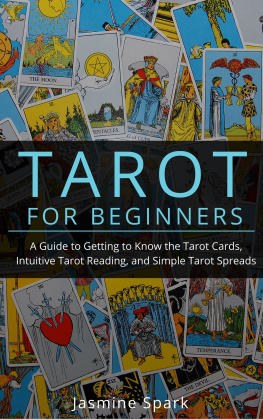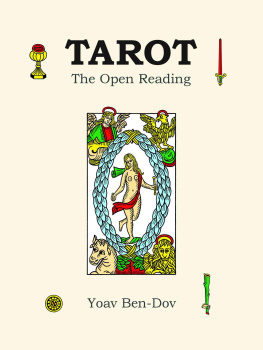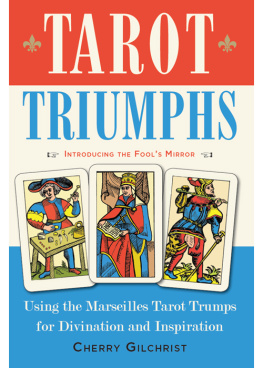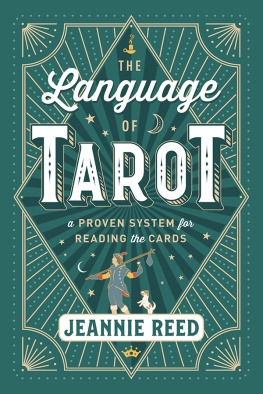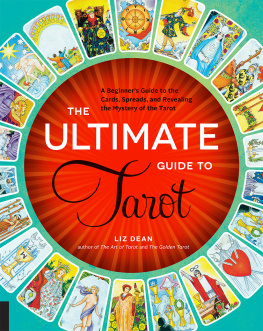The Tarot Grimoire
The Magick of the Opening of the Key Spread
Henry Ho
About the Author
Henry started his study of the Tarot and Western Magick at age 20. Since then, the occult has been his main obsession. Henry continues to explore magick in all its forms, from High Magick, Shamanism, Reiki, Tantra and Taoism. He published his first book on the tarot in late 2013, runs a blog and YouTube channel on all things esoteric.
Henry lives in London with his wife and two cats.
www.starrytarot.com
YouTube: Starry Tarot
Other Books by Henry Ho
Tarot and the Path of Initiation
The Tarot Grimoire Copyright 2017 by Henry Ho. All Rights Reserved.
All rights reserved. No part of this book may be reproduced in any form or by any electronic or mechanical means including information storage and retrieval systems, without permission in writing from the author. The only exception is by a reviewer, who may quote short excerpts in a review.
Cover designed by Henry Ho
Henry Ho
Visit my website at www.starrytarot.com
CONTENTS
Introduction
I began my study of the tarot in 2011. For many months I struggled with the meaning of the cards and using the Celtic Cross spread. During the summer I discovered the YouTube channel by Paul Hughes-Barlow, who is a champion of this tarot spread in the modern era. This spread is the one I now use almost exclusively due to the clarity of its messages. It is the tarot system that launched me from a beginner to a competent reader. I would like to share it with the tarot community in this book, to help promote this still relatively unknown tarot spread despite its virtues.
Little is known about the origins of the spread apart from the fact that is was created by the order of the Golden Dawn, whose curriculum has influenced the whole of modern ceremonial magick. The Rider-Waite tarot deck, created by one of the members of the order, Arthur Edward Waite, has become the template for many tarot artists after its creation. Whilst the images of the deck have been highly popularised, two aspects of this Golden Dawn tarot deck has been heavily ignored by many in the modern tarot community. The Qabalistic and Astrological correspondences, and the Opening of the Key spread.
My first book, Tarot and the Path of Initiation, addressed the first issue. It was sad to see that these correspondences that were used to imbue the cards with meaning have been forgotten. The Thoth tarot, however, made these correspondences overt in their design, unlike the Rider-Waite which chose to hide them. It is important for knowledge of any kind to be published, lest they perish from secrecy. If it does not survive in the minds of men, and in books, then it may as well have not existed.
This book addresses the second shortcoming. The Opening Key Spread is one of the leading innovations by the Golden Dawn on the tarot, yet it is being left behind. Few tarot readers even know of its existence.
Perhaps there is valid reason for this. It is a tarot spread that requires the reader to learn various skills that are not used in more mainstream spreads that rely on positional meanings. The learning curve of this spread is not a short one. It took around half a year of reading almost every day for me to feel that I can read competently with this spread. In total it took a whole year of reading the cards almost every day before I felt I totally mastered this spread.
Likely it will not take most of my readers this long to learn this spread. Bear in mind that I was a total beginner when I first learned this spread. Most of you, my readers, are likely to have had much tarot experience under your belt already. My wife is the first person I taught the spread to, and it took just one sitting for her to be able to utilise the spread on her own.
The other issue is that in its original form, it is a very long reading. There are five operations to the reading. Essentially it is five readings in one, and the individual sections are already very long on their own. When I started out it took me a whole hour per reading to just do the first operation. Now it takes me around ten minutes.
So why use this spread at all? Because once mastered this spread is the most adaptable and clear of all. It reaches levels of depth that other readings can barely scratch the surface of. The flexibility of the deck makes it adaptable for any question, no matter how mundane or spiritual.
Positional spreads rely on the predetermined meanings of the placement of the cards in order to give context. This inherently boxes the cards into a limited sphere of meaning. The result is that most spreads are only suitable for certain types of questions.
The Opening of the Key style of reading places an emphasis on the relationship between the cards in order to create the same context. I have found this to be a much richer, dynamic way of reading the cards, and looking at life. Once you have learnt this spread, you will need no other.
In short, it is a form of tarot that may be more suitable to certain individuals than conventional positional spreads. I have found that I was able to give very clear readings as a beginner before my intuition was developed. Through reading with this spread I have felt that my intuitive muscles have been trained and developed greatly.
Structure of this book
Part 1:
The Significator
The First Operation
Analysing a String
Elemental Dignities
Card Counting
Catalysts of Change
Card Pairing
These chapters examine the fundamental mechanics of reading the OOTK spread that is common to all five operations. I will be using the First Operation to showcase each of the techniques in depth.
Part 2:
The Astrological Operations
The Fifth Operation
Here we will analyse each operation individually, go through their mechanics and discuss their uses in practice.
Part 3:
Energy Manipulation
Scrying and Astral Projection
The Spirits of the Tarot
Here we will explore how we can combine the OOTK spread with magick. How tarot itself is a complete system of magick, and also how the OOTK spread can be used to give us advice on what kind of magick to use for us to get the results we desire, and how to craft our rituals.
Part 4:
The Golden Dawn Attributions
Tarot Mirroring
Tarot and the Hebrew Alphabet
Meeting the Holy Guardian Angel
This section serves as an Appendix to the rest of the book. A list of articles that are useful commentaries for tarot readers.
Notes
References
I will be drawing upon these sources as my main reference material. My readers are encouraged to explore them on their own.
The Book of Thoth by Aleister Crowley
The Tarot and the Magus by Paul Hughes-Barlow
The Golden Dawn by Israel Regardie
Titles
I will also be referring to the tarot cards by their titles given in the Thoth Tarot Deck. If you are not familiar with the deck, this is how it differs to the Rider Waite:
The Knights:
The Knights are still called knights, but they are the real Kings of the Court Cards. This is because the man on a horse represents Yod in the Golden Dawn system, and therefore they are the Fathers in the families of the courts. Therefore Knights represent older male figures, even though they embody the dynamic energy of fire.
The Princes:
The Kings in the Rider Waite Deck are changed into Princes in the Thoth. This is because in the Golden Dawn system, the Kings/Princes represent Vau, or the Son in the Court card families. The Kings represent younger male figures. This is because the man on a chair or a chariot has combined the active influence of the Father/Knight with the passive energy of the Mother/Queen to create the throne/chariot. This creates the element of Air, active movement tempered by passive contemplation.
Next page

